Chawan Kazari
Cha-wan Kazari, 茶碗荘, Tea-bowl Dignify, in Garandō
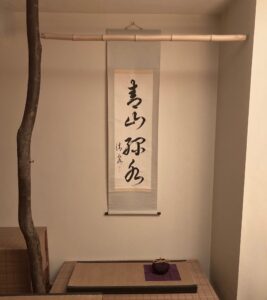
Pictured above is the tokonoma is as it might appear during the first seating of a Cha-ji, 茶事, Tea-matter, which is called sho-za, 初座, first-sit, and sho-iri, 初入, first-entry, before a Tea presentation of ‘Cha-wan Kazari’, 茶碗荘, Tea-bowl Dignify. Chawan Kazari and preparing the Tea, takes place in the gō-za, 後座, latter-sit, or gō-iri, 後入, latter-entry. The room is darkened to subdue the atmosphere as food and drink are offered.
The word kazari has some issues. The Kanji for kazari in chawan kazari is 荘, also read sō. The common understanding of kazari in standard Japanese language is often understood to mean display, kazari, which is written with the Kanji, 飾. In Chanoyu, kazari, 荘, usually means manor, house, villa, dignified, solemn. The word kazari, as it relates to solem, means performed with due religious ceremony or reverence, sacred, devoted to religious observances, and is meant to inspire devout reflection.
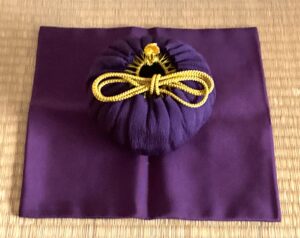
A chawan of distinction is enclosed in a purple silk drawstring go-motsu bukuro, 御物袋, hon.-thing bag, displayed on an opened fuku-sa, 帛紗, cloth-gauze throughout the shoza. During the naka-dachi, 仲立, middle-standing, the kyaku, 客, guest, leave the Tearoom.
During the nakadachi, the tei-shu, 亭主, house-master, removes the chawan and kakejiku, and displays the cha-bana, 茶花, tea-flower, in the tokonoma. The spiritual word of the hanging scroll which is Yō, 陽, Yang, positive, is replaced by the physical flower, which is In, 陰, Yin, negative. During the day, the window blinds are removed, which lets in the light. The darkened room is In, and the natural light changes the room to Yō.
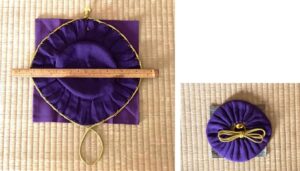
On the left, the go-motsu bukuro, 御物袋, hon.-thing-bag, is shown fully opened and laid flat on a fuku-sa, 帛紗, cloth-gauze. The diameter of the gomotsu bukuro is approximately 8 sun kujira-jaku. The full length of the yellow cord, o, 緒, is 40 sun kane-jaku, or 32 sun kujira-jaku, and is held to the circumference of the gomotsu bukuro by 41 thread loops, kagari ito, カガリ糸. The cord length of 32 sun kujira-jaku may evoke the 32 different manifestations of Kan-non Bo-satsu, 観音菩薩, See-sound Grass-buddha, who is the Buddhist goddess of mercy.
The empty, tied gomotsu bukuro diameter is approximately 6 sun kane-jaku or 4.8 sun kujira-jaku. A gomotsu bukuro with a diameter of 4.8 sun kujira-jaku has an area of 18.09 sun kujira-jaku.
The ko-buku-sa, 古帛紗, old-cloth-gauze, is 5 x 5.2 sun kane-jaku or 4 x 4.16 sun kujira-jaku. The area of the kobukusa, which measures 4 x 4.16 sun kujira-jaku, is 16.64 sun kujira-jaku. The ratio between the sizes of the gomostu bukuro and the kobukusa is approximately 9:10.
The gomotsu bukuro is made of murasaki chiri-men, 紫縮緬, purple shrink-fine thread, crepe, with yellow cord, opened and laid on an open purple fuku-sa, 帛紗, cloth-gauze. The gomotsu bukuro is made to protect a cha-wan, 茶碗, tea-bowl, and to conceal its appearance when displayed in the tokonoma. The fukusa is used by the teishu to purify certain Tea utensils. Both fabric items are used to display a chawan in the tokonoma.
The fukusa is made of a rectangle 8 x 16 sun kujira-jaku that is folded in half and hemmed on three sides resulting in a rectangle of 7.2 x 7.6 sun kujira-jaku or 9 x 9.5 sun kane-jaku. This latter measurement is given by Rikyū on the size of the fukusa. Weavers use the kujira-jaku for measurements.
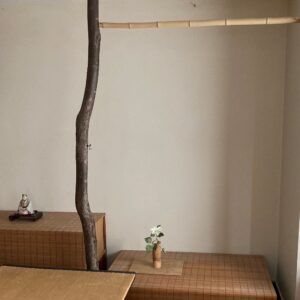
Flowers for a Tea gathering are called cha-bana, 茶花, tea-flower, and are not flowers of the tea plant. In a Chaji, flowers are displayed in the tokonoma during the gō-za, 後座, latter-sit, when Tea is presented to the guests. The hana-ire, 花入, flower-receptacle, pictured above, is a length of aged bamboo; L. 6.5 sun kane-jaku, displayed on a wet sugi, 杉, cedar usu-ita, 薄板, thin-board, called a hamaguri–ba, 蛤葉, clam-leaf.
The bamboo flower vase is placed ge-za, 下座, down-seat, the lower side of the tokonoma. The metaphorically ‘revered location’ of the standard yojōhan Tearoom is called kami-za, 上座, upper-seat, and is the upper right back corner of the tokonoma. Curiously, this direction is named ki-mon, 鬼門, demon-gate. The ‘lowest’ location in the yojōhan is the southwest corner, and is the teishu’s door called the cha-dō guchi, once called sa-dō guchi, 茶道口, tea-way entrance, and also called ura-ki-mon, 裏鬼門, inner-demon-gate.
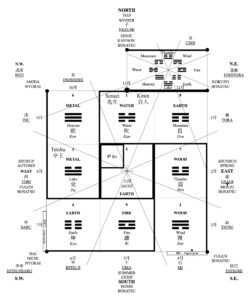
Diagram of a yo-jō-han cha-shitsu, 四畳半茶室, four-mat-half tea-room, identified with the various aspects of Japanese culture including solar and lunar calendars, Buddhism, The I Ching, in Japanese Eki-kyō, the twelve signs of the Asian zodiac, etc.
The hana-ire displayed in the tokonoma is placed in center or to the left of center marked with the sign for Water. This area is protected by Kan-non Bo-satsu, 観音菩薩, See-sound Grass-buddha. The area where Tea is prepared by the teishu, West, is the left one-third of the yojōhan. The right two-thirds of the room, East, is for the kyaku.
The yojōhan chashitsu of Sen Rikyū is divided into the three areas: the tokonoma, the area of the teishu, where Tea is prepared, which is the western third of the yojōhan, and the remaining three mats for the guests. Each area has a ceiling of different height. The tokonoma has the highest ceiling, and the area of the host has the lowest ceiling.
A bronze or porcelain hanaire would be placed in the center of the tokonoma. Flowers are flowers. Hanaire are divided into three classifications, and are displayed on a particular rectangular board in a tokonoma that has tatami flooring:
Shin, 真, true, formal; Chinese bronze, porcelain, etc.; shin-nuri ya-hazu-ita, 真塗矢筈板, true-lacquer arrow-nock-board.
Gyō, 行, transition, semi-formal; Japanese glazed ceramic, etc.; shin-nuri hamaguri ba, 蛤葉, clam-leaf.
Sō, 行草, grass, informal; bamboo, unglazed ceramics, ki-ji ita, 木地板, wood-ground board, plain wood, made wet.
Small, bamboo, Raku copies of bronzes; maru-ita, 丸板, round-board with clamshell edge.
Kago, 籠, basket, does not require a board as water is contained in a separate container inside. Bamboo is relatively everlasting, except that it can crack with changes between wet and dry.
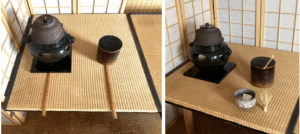
Chawan Kazari placement of the furo/kama and mizusashi. The chashaku, chakin, and chasen are temporarily carried in a kae-ja-wan, 替茶碗, substitute tea-bowl, to be placed on the mizusashi lid. Chashaku is placed on the right side of the lid, the chasen is momentarily placed on tatami, the chakin to be placed on the lid in front of the arc-shaped handle, then the chasen on the chakin. The kae-jawan could be used afterwards to offer usu-cha, 薄茶, thin-tea.
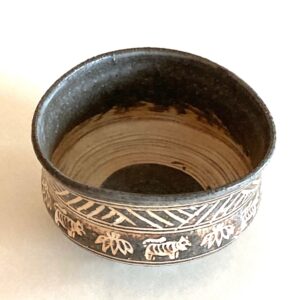
The above photographs, and the measurements that follow here, are all on Kyō-tatami. The above photograph on the left shows the placement of the portable fu-ro/kama, 風炉/釜, wind-hearth/kettle, on its protective shiki-ita, 敷板, spread-board, on the left side of the tatami, the mizu-sashi, 水指, water-indicate, is on the right side of the tatami.
The bronze furo is placed on a black-lacquered shiki-ita, 敷板, spread-board, 9.5 x 9.5 sun kane-jaku. The board is placed so that its center point is 7 sun kane-jaku left of the center of the tatami. The actual size of the tatami is somewhat irrelevant, and the measurements are made from the middle of the tatami. The front edge of the board is 16 tatami me from the heri of the adjoining tatami, or 18 tatami me from the knee line of the teishu. This is the equivalent of 8.8 sun kane-jaku. The number 88, hachi-jū-hachi, 八十八, is symbolic of Infinity in Space.
The mizusashi is located so the center point of the vessel is 7 sun kane-jaku to the right of the middle of the tatami. The standard Seto hitoe guchi mizusashi has a diameter and height of 5 sun kane-jaku. The measurement between the front plane of the mizusashi and the knee line of the teishu is 8.8 sun kujira-jaku. The distance between the center of the furo/kama and the center of the mizusashi is 14 sun kane-jaku. This measurement is the width allotted to a person, and especially for the teishu.

Left: Chawan Kazari utensils as seen first seen when guests enter. Center: additional utensils for the presentation procedure. Right: the arrangement of utensils as seen from the vantage of the shō-kyaku, 正客, correct-guest, in a yo-jō-han, 四畳半, four-mat-half, room.
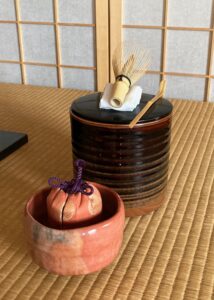
Mizu-sashi, 水指, water-indicate, Se-to hitoe-guchi, 瀬戸単口, Rapids-door one layer-opening, Izumi-gama, 泉窯, Spring-kiln, with black-lacquered lid; H. 5 x 5 sun kane-jaku. Cha-kin, 茶巾, tea-cloth, dampened asa, 麻, hemp, 5 x 10 sun kane-jaku. Cha-sen, 茶筅, tea-whisk, take, 竹, bamboo; L. 3,75 sun kane-jaku (3 sun kujira-jaku). Cha-wan, 茶碗, tea-bowl, with red slip and clear glaze, by Yoshi-mura Sō-raku, 吉村宗楽, Luck-town Sect-pleasure: 2.7 x 4 sun kane-jaku. Cha-ire, 茶入, tea-receptacle, by Ichi-no Katsu-ki, 市野勝磯, City-field Win-shore, wrapped in shi-fuku, 帛紗, serve-cover; full height 4 sun kane-jaku.
The full height of the chaire, including the upright, braided thread uchi-dome, 打留, hit-fasten, in the chawan is 4 sun kane-jaku. The height of the mizusashi including the lacquered lid is 4 sun kujira-jaku.
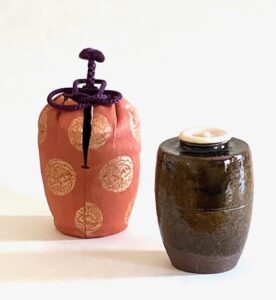
Cha-ire, 茶入, tea-receptacle; brown ceramic container, kata-tsuki, 肩付, shoulder thrust, with clear to brown glaze, Tan-ba yaki, 丹波焼, Red-wave fired, by Ichi-no Katsu-ki, 市野勝磯, City-field Win-shore; h. 2.7 sun kane-jaku. The tea container is an adaptation of the famed Se-to cha-ire, 瀬戸茶入, Rapids-gate tea-receptacle, named, ‘Yari no Saya’, 槍の鞘, Spear ’s Sheath. The chaire pictured above has a shi-fuku, 仕覆, work-cover, made of pink silk fabric with a pattern called ‘Futari Shizuka’, 二人静, Two-person Quiet, made in the style of kin-ran, 金襴, gold-brocade.
Note the scored line, dō-himo, 胴紐, body-cord, around the middle of the chaire, which is parallel with the small, tack stitch, called tsuyu, 露, dew, or in sewing terms, functions as a ‘seam stay’, that secures the slit opening, or machi, 襠, side opening, of the shifuku. A tsuyu stitch is also on the machi at the back of the shifuku. Quite often, when holding the chaire, the thumb is placed on the dōhimo, at the shōmen, which usually aligns with the tsuyu stitch of the shifuku.
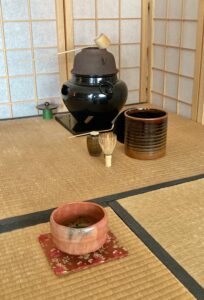
A very special cha-wan, 茶碗, tea-bowl, containing koi-cha, 濃茶, thick-tea, is presented on a ko-buku-sa, 古帛紗, old-cloth-gauze, offered by the tei-shu, 亭主, house-master, to the kyaku, 客, guest, at a Cha-kai, 茶会, Tea-gathering.
The chawan, pictured above, is a cream-colored ceramic bowl with a red slip and clear glaze, called aka-Raku, 赤楽, red-Pleasure; diam. 4 x 2.7 sun kane-jaku, made by Yoshi-mura Sō-raku, 吉村宗楽, Luck-town Sect-pleasure, for Gin-kaku-ji, 銀閣寺, Silver-pavilion-temple, Kyōto. The ko-buku-sa, 古帛紗, old-cloth-gauze, is of a herringbone weave called shō-ha-ori, 紹巴織, inter-comma-weave, with a pattern of chickens and floral motifs; 5.2 x 5 sun kane-jaku, by Kita-mura Toku–sai, 北村徳斎, North-town Virtue-abstain, Kyōto.
The reason for presenting ‘Chawan Kazari’ is to feature a teabowl that has special significance to the teishu or kyaku. Once, only a highly esteemed historical teabowl was prominent enough for such an honor. The reason for selecting this particular aka-Raku cha-wan, 赤楽茶碗, red-Pleasure tea-bowl, is that it was a souvenir after my being a guide for the Urasenke group of students called Midorikai, in the Tō-gu-dō, 東求堂, East-request-hall, of Ginkakuji, in the 1980s. The kobukusa was a gift from one of the students.
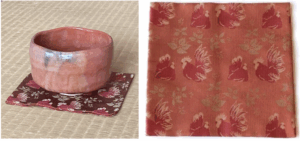
Ko-buku-sa, 古帛紗, old-cloth-gauze, shown with and without the chawan, Mei-butsu 名物, Name-thing, Niwatori shō-ha don-su,鶏紹巴緞子, Chicken introduce-comma damask-of; fabricated by Kita-mura Toku-sai, 北村徳斎, North-town Virtue-abstain, Kyōto. The fabric ‘square’ is 4 x 4.2 sun kujira-jaku, is doubled, with hems on three sides: the wasa, わさ, fold, is along the right side. The word shōha, 紹巴, refers to the configuration of the weave that is elsewhere called herringbone.
When preparing to retrieve the prepared tea, the shōkyaku moves toward the chawan, kyaku says to the teishu, “kobukusa wo hai-shaku itashimasu.” – hai-shaku, 拝借, respectful-borrow, humbly borrow, and taking both the bowl and kobukusa returns to his or her place.
It is important to raise chawan when turning the chawan on the left hand, especially when the chawan is on a kobukusa. Turn the chawan, not the kobukusa, except when returning the chawan to the teishu. If the chawan was presented on a kobukusa, the chawan is returned the same way. If the kobukusa was offered separately, the kobukusa is returned alongside the chawan.
The kyaku should handle the chawan in the manner in which the teishu offers the bowl. In Chawan Kazari, the chawan should never be placed directly on the tatami, but kept on the kobukusa. In addition, the kobukusa should support the chawan when the kyaku is drinking tea from the bowl.
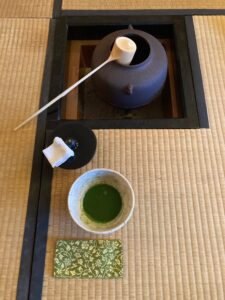
When serving koi-cha, 濃茶, thick-tea, in a chawan that is not Raku yaki, 楽焼, Pleasure-fired, the teishu offers a kobukusa the option of supporting the chawan. The above photograph shows koicha in a Hagi-yaki chawan with an accompanying kobukusa, as presented when using the sunken hearth, ro, 炉, hearth.
In the Tea presentation, Chawan Kazari, the chawan is presented on a kokubukusa regardless of whether the chawan is Raku or not.
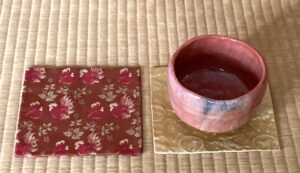
After drinking the tea, the chawan and kobukusa presented by the teishu, are examined by the kyaku, that is called hai-ken, 拝見, respectful-look. The kyaku places their kobukusa to the right of the chawan, and after examining the chawan, places the chawan on their own kobukusa in order to examine the teishu’s kobukusa. Therefore, two different kobukusa are placed side by side.
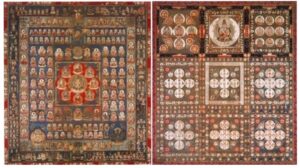
The numbers 18 and 9 as well as 16 and 64 are highly symbolic. The number 9, kyū, ku, 九, may be identified with the nine realms of the Kon-gō-kai Man-da-ra, 金剛曼荼羅, Gold-strength-world Wide-weed-spread, and the Tai-zō-kai Man-da-ra, 胎蔵界曼荼羅, Womb-keep-world Wide-weed-spread, which are essential aspects of Buddhism. The kobukusa is doubled fabric – 9 and 9.
16 and 64 – 16 times four is 64, there are 64 hexagrams in the I Ching, Eki-kyō, 易経, Change-classic.

Unstitched and opened kobukusa showing its full size and unfolded hemmed edges: 6 x 12 sun kane-jaku, or 4.8 x 9.6 sun kujira-jaku. Length minus two hems of 5 bu kujira each, which equals one sun kujira, makes the length 8.4 sun kujira-jaku. The width of 6 sun kane-jaku, minus two hems of 5 bu kane-jaku (4 bu kujira-jaku) makes the width 5 sun kane-jaku (4 sun kujira). Using both kane and kujira-jaku illustrates the interconnection uniting both measurements.
The fabric pattern is Rikyū-bai don-su, 利休梅緞子Rikyū-‘plum’ damask-of. The kobukusa was a souvenir of participation in an intensive study period, kō-shū-kai, 講習会, lecture-learn-gathering, seminar, given at Urasenke in Kyōto. The fabric is frayed from excessive use. So much was revealed when the kobukusa was opened. Questions arise, such as why the kobukusa is not an exact square. The function of the kobukusa includes placing it directly on the tatami, whereas the chakin is never placed on the tatami.
One of the prime functions of the kobukusa is to support a chawan, which is placed on the tatami floor. The width of the kobukusa, 4.2 sun kujira-jaku, may have been determined by the size of Kyō tatami, which is 25 sun kujira-jaku. This dimension is equal to six kobukusa laid side by side. Excerpt for an additional 2 bu kujira-jaku.
The width of Kyō tatami is 25 sun kujira-jaku or 31,25 sun kujira-jaku, divided by 6 the number of infinity in time, is 4.1666 to infinity. The width of the kobukusa is 4.2 sun kujira-jaku. The width of Kyō tatami is 25 sun kujira-jaku, which is equal to six kobukusa laid side by side, plus 2 bu kujira-jaku.

Six kobukusa (5.2 sun kane) lengths (31.2 sun kane) approximately equal to the width of Kyō-tatami (31.25 sun kane).

Six kobukusa (5 sun kane) widths equal to 30 sun kane-jaku width of chū-Kyō tatami. (Kobukusa shown on Kyō tatami width 31.25 sun kane-jaku.)
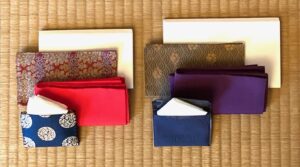
Left: women’s fabric and paper paraphernalia. Right: men’s fabric and paper paraphernalia. Included are ko-ja-kin, 小茶巾, small-tea-cloth, and containers.
According to customs, the kobukusa together with the fukusa and pack of kaishi are kept together in the front folding of the kimono, which is called the futokoro, 懐, which is also read, kai. This location gives the pack of papers the name of kai-shi, 懐紙, ‘heart’-paper, and for the kai-chū ko-buku-sa, 懐中古帛紗, ‘heart’-middle old-cloth-gauze. Each of the fukusa, kobukusa, and kaishi are folded in half.
The actual location of the items varies for men and for women wearing kimono. The futokoro is in front of the abdomen, just above the obi, as with men’s kimono. For women, because the obi is wide, the futokoro is in front of the sternum. The location for these utensils finds a correlation in Taoist anatomy within a concept known as the three dantians, lower middle and upper, respectively.
In Japanese dantian is known as tan-den, 丹田, red-rice field. Men’s futokoro corresponds directly with the point below the navel called the Lower Dantian’. Women’s futokoro corresponds directly with the point near the heart, called the Middle Dantian. The Upper Dantian is located in the brain, which is one area affected by drinking tea. When drinking the last sip of tea from a chawan, the shōmen of the bowl touches the forehead close to the Upper Dantian, which may be identified with the urna, or, byaku-go, 白毫, the whorl of white hair on the forehead of the Buddha.
The three dantian, sometimes referred to as cauldrons, are areas of focus for internal meditative techniques. The concept, particularly of the Lower Dantian, is also found in the meal that is served in a Chaji, which is called kai–seki, 懐石, heart-stone, and that has its origins in the Buddhist custom of placing a heated stone, seki, 石, wrapped in a towel in the kimono in front of the belly to ward off the pangs of hunger.
Perhaps placing the kobukusa by itself on the floor toward the guest in anticipation of having it support the chawan, may evoke some of the above mentioned customs.
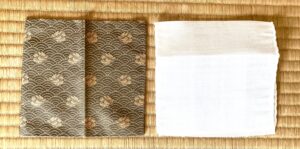
Ko-buku-sa, 古帛紗, old-cloth-gauze, rectangle of fabric folded in half to form a ‘square’ and hemmed on three sides; 5 x 5.2 sun kane-jaku. The cha-kin, 茶巾, tea-cloth, 5 x 10 sun kane-jaku, is hemmed on two long sides, and folded in half to form a ‘square’; 5 x 5 sun kane-jaku. It may be that originally, the un-hemmed fabric was 5 sun, and after hemming was not square.
Cha-kin, 茶巾, tea-cloth, asa, 麻, hemp, rectangle of fabric hemmed on two long sides, folded in half to form a ‘square’. The dry kobukusa, Yō, is folded in half vertically, and the wet chakin, In, is folded horizontally.
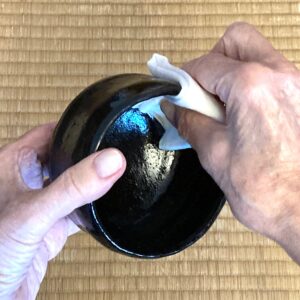
The host wipes and dries the chawan with a damp cha-kin, 茶巾, tea-cloth, made of asa, 麻, hemp, linen. The chakin is made in several sizes: 10 x 10 sun kane-jaku square, most formal, and half the size 5 x 10 sun kane-jaku, which is the most common, and a smaller ko-ja-kin, 小茶巾, small-tea-cloth, that measures 4 x 6 sun kane-jaku. The kojakin is used by the guest to wipe the chawan after drinking one’s own portion of koicha. Kami ko-ja-kin, 紙小茶巾, paper small-tea-cloth, are available on the market.
The damp kojakin length, 6 sun, is folded into thirds, to form a strip 1.333 to infinity wide, then in half, 3 sun kane-jaku, and folded again in half to form a rectangle 1.333 to infinity x 1.5 sun kane-jaku. Their ratio is 10:888666 to infinity. The number eight, hachi, 八, is symbolic of Infinity in Space, and the number six, roku, 六, is symbolic of Infinity in Time. The ratios found in the kojakin allow the guest power over Infinity in Time and Space. This manner of folding the kojakin creates 12 rectangles.
The teishu wipes and dries the chawan with a standard half chakin, with the thumb on the inside of the bowl, and the fingers outside of the bowl. The half-unfolded chakin is draped over the rim of the bowl with the fold on the outside. The chakin is wiped in a clockwise motion around the bowl starting at the top and moving to the thumb of the left hand that holds the bowl. The bowl is held with the chakin and is rotated counterclockwise to the left hand thumb. This is repeated three and approximately one-half times to adjust the location of the shōmen. The bowl completes a single rotation in three-plus movements.
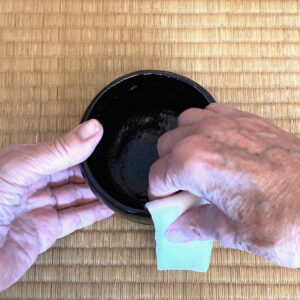
After drinking tea, the guest wipes the rim of the chawan with the gradually unfolded kojakin where one drinks, nomi-kuchi, 呑口, drink-mouth. The kojakin is held between the thumb and the fore-finger, with the thumb on the outside of the bowl, and the fingers inside the bowl, with the fold of the kojakin inside the bowl. This positioning of the chakin fold and the finger and thumb position is precisely the opposite of the teishu’s. The stroke is front left to right about the width of the folded kojakin.
This area of the chawan is identified with the North, the Asian zodiac sign of Ne, 子, Child, and Sen-ju Kan-non Bo-satsu, 千手観音菩薩, Thousand-hand See-sound Grass-buddha. Kannon has 32 different manifestations. One of them is Jū-ichi-men Kan-non, 十一面觀音, Ten-one-faces See-sound, has eleven heads as part of the crown, and does not include the figure’s own head. Thus, the Juichimen Kannon has twelve faces, jū-ni-kao, 十二顔, ten-two-faces.
A single sheet of kaishi is often used in lieu of the fabric kojakin. Men’s kaishi measures 5.8 x 6.8 sun kane, and women’s kaishi measures 4.8 x 5.8 sun kane. There are some slight differences between the measurements of both kaishi and kojakin.
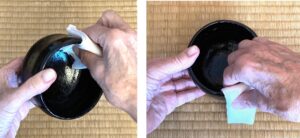
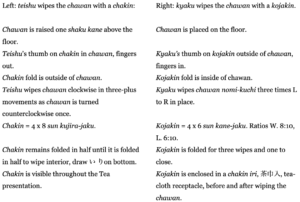
There are several ways that an object, such as a chawan, receives hako-gaki, 箱書き, box-writing, from a master. The following is one way of progression of acquiring, for a chawan. A potter makes a chawan, and would like to have a master sign the box to enhance its quality and value. The master agrees to the project, and may receive remuneration from the potter. For example:
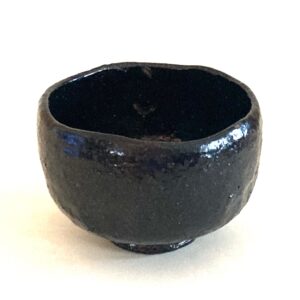
Cha-wan, 茶碗, tea-bowl, ‘kuro Raku’, 黒楽, black-Pleasure, ceramic vessel with rough black glaze throughout, diam. 4 sun kane-jaku, by Raku Ryō-nyū, 楽了入, Pleasure Complete-enter, [1756 – 1834] 9th generation Raku. Visible at the back of the interior of the chawan is the indentation from the tongs used to remove the semi-molten bowl from the kiln. Each Raku potter makes their own unique iron tongs, which can be used to verify the potter’s identity.
The chawan is prepared.
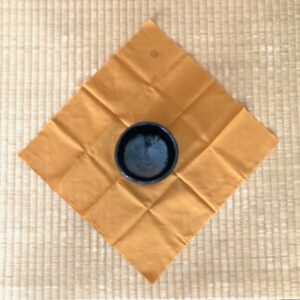
The chawan is wrapped in a large piece of u-kon mo-men, 鬱金木綿, turmeric-gold wood-cotton, that repels insects. It may bear the stamp of the artist – which is the dark spot near the top of the cloth.
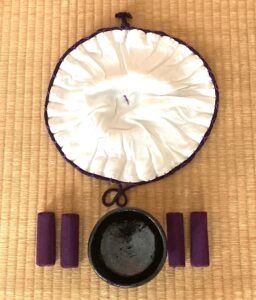
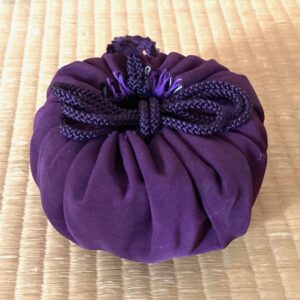


Often by writing on the front of the box, the potter identifies the object within, signs and stamps it. The box is usually tied with flat cord called Sana-da himo, 真田紐, True-field cord: certain colors and color combinations may be identified with a particular family name. It is advisable for a potter to sign the front of the box rather than the top outside of the lid, so that the underside of the lid can be free for the hako-gaki of a master.
Note the end wood grain of the lid is in accord with the end wood grain box, so that it creates a kind of matching frame.
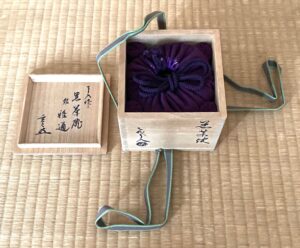
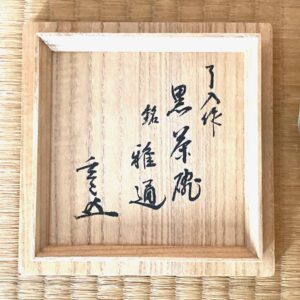
Underside of the box lid for the chawan, with hako-gaki, 箱書き, box-writing: from top right – Ryō-nyū saku, 了入, Complete-enter make – kuro cha-wan, 黒茶碗, black tea-bowl – mei miyabi-michi, 名雅道, name Elegant Way – Shitsu, 室, Room (ka-ō, 花押, flower-seal), is the stylized generation number jū-go, 十五, 10-5, for Hōunsai, XV Iemoto, Urasenke, Kyōto.

A sheet of paper covers the box, and may have identifying writing. Having the information about the piece written on the front makes it easy to identify when many boxes are stacked in storage.
Regrettably, this particular chawan, box, and written information was created with the intent to defraud. The bowl and box and paraphernalia do exist, but the vetting and identification are fraudulent, and meant to deceive. This is detailed here as a warning to potential purchasers, particularly with objects seen on the internet. When I acquired the bowl, I sensed it was a fake, yet was intrigued by the accoutrements that came with the bowl. Its cost was worth having it as an example to caution others. The chawan on its own is quite serviceable. Be aware!
For further study, see also: Kobukusa Collection and Tea in June

